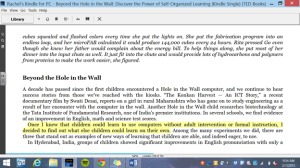In the first half Sugata Mitra’s Beyond the Hole in the Wall: Discover the Power of Self-Organized Learning, he explores a scientific experiment that ultimately results in the idea of minimally invasive education (MIE). This form of learning happens when children learn in environments with minimal adult direction or supervision, instead governing their own acquisition of knowledge. I found the entire research project to be incredibly interesting, particularly the various characteristics identified that did not impact the ability to engage in MIE as well as the number of skills (and their far-reaching impact) that children were able to acquire simply by having free and public access to a computer with Internet (Mitra, 2012). For instance, Mitra (2012) notes that students were able to teach themselves another language enough to navigate email, chat, and search engines and even improved their math and science scores in school.
Ultimately, this reading reminds me that children do like to learn. They think about so many parts of the world around them and soak up information like sponges, easily and constantly creating connections between various schemas in their minds. They are natural explorers using their senses to learn about the world around them. And yet, by the time they arrive at high school, they seem over it to a certain degree. Naturally, a part of this is simply the cynicism that comes with suffering through puberty, but I can’t help but wonder if part of it is also how structured and rigid schooling has become. If students had more ownership of their learning, more opportunities to simply explore the answers to questions that they had, would they do better in school? It reminds me a bit of how some companies allow a “free” day whereby people work on independent projects at work, and yet this “free” day ultimately results in increased innovation and productivity in the workplace. Would our students learn more and enjoy learning more if we provided more opportunities for them to learn about the things they wanted to learn about?
One of the biggest considerations I have about the reading in relation to my students is how I can structure projects into their time at school that capitalize on minimally invasive education with technology while still meeting standards for various content areas. At the secondary level in an EBD classroom, attendance is a significant issue, which means I’m often working on remediation of basic skills rather than having students work on projects that advance their skill set. In addition, the skill level of my students often requires considerable scaffolding for progress. How can I continue to provide support but also offer opportunities for independent exploration and learning? How can technology help me do that? One idea is offering a small break whereby a student can research a topic for twenty minutes before coming back to discuss what he or she has learned. Skills practiced could include synthesizing ideas learned, navigating the Internet and finding reliable sources, along with many others.
With regards to the Kindle Reader, I have finally hit my stride in use. I hardly notice what I originally perceived as inconvenient about it, instead finding it nice that I can easily do my reading during a lull at work. In addition, when I use it on my iPad, I no longer struggle with visual tiredness, as that screen is far better equipped for being read on. I easily read through, clicking through the pages and highlight information I find interesting. In fact, I felt that I read my assigned reading for this book much quicker than the last (though, I also prefer the writing style of this author, so that may be a variable). Overall, I find myself not nearly so reluctant to use the technology.
Mitra, Sugata (2012). Beyond the Hole in the Wall: Discover the Power of Self-Organized Learning [Kindle Single]. Retrieved from Amazon.com.

